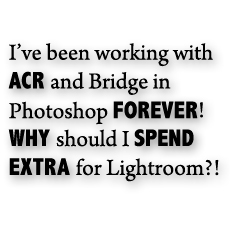One-on-One Training

"Time is money." So spake Benjamin Franklin back in the eighteenth century and never more has that adage been true than today.
My Adobe Lightroom training sessions last two hours though some clients prefer to keep going – four even six hours if they feel like they are on a roll.
I sit with you at your computer in-home, your office or studio. After all, watching someone conduct an imaging process on a projector screen in a classroom setup is often not the most effective way for learning and retaining – especially if you are forced to work on an all-together different Operating System than what you are used to. You need to be the one driving your machine to learn most effectively .
There is nothing quite like having an experienced and conversant mentor as a personal guide providing insightful encouragement as you perfect your skill-set editing your own photographs, not some exercise files.
Patient, targeted assistance focused on each client's needs at a pace tailored to however one feels most comfortable – this is how I have developed the One-on-One Lightroom (and Photoshop) training I provide.
Contact me via email or by phone and we can talk about how best to attend to your goals: info@phoenixlightroomenterprise.com or 602-225-3737.

This is the most persistent call for help I get.
Lightroom's database method of image organization and management is not the same as working with Adobe Bridge, the Mac Finder or a PC's Explorer – all browser applications.
Lightroom is faster when responding to a search and is more accurate as well.
When set up and used correctly Lightroom provides you the ability to find the proverbial "needle in a haystack" – in a flash.
However, I have seen so many variations on the problem of multiple catalogs and copies of image folders spread across multiple internal and external hard drives it would be nearly impossible describing them all here.
Point is, the mess has to be fixed or you will be losing more and more productive time and becoming all the while more frustrated with this elegant and sophisticated application!
Working in a collaborative shop means that colleagues are all sharing files over a network utilizing Adobe Bridge. Terrific. Makes sense.
However, Bridge does not provide many of the features Lightroom does – each essential to a photographer's most efficient and productive workflow.
It is important to learn how Lightroom can be optimally utilized within a CS-CC/Bridge-centric workplace.


History. Virtual Copies. Database search speed and accuracy (the Catalog). On-the-fly rendering in the Lightroom Navigator – all things a Camera Raw/Bridge workflow does not provide or that Lightroom does for a photographer way better!
It's a bright sunny day.
The groom is in a handsome, charcoal-gray pinstripe suit; the bride in white (of course). Her dress is phenomenal; it is so elegant and elaborate.
Shoot the wedding JPEG-only (as so many point-and-shoot-digicam to digital-SLR recent converts do) and you've likely lost detail within the darkest elements of the image (the groom’s formal wear) or worse, in the blown-out details of that stunning white dress.
You won't get the detail back. You can't tweak-back the lost detail in a JPEG capture. It's gone forever.
However, by shooting Raw one still has the ability to rescue a problematic exposure.
